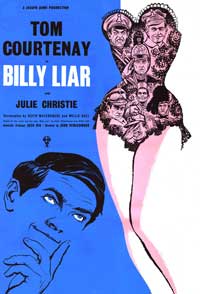Elmer Gantry

Based on Sinclair Lewis’s controversial, apparently dangerous 1927 novel of the same name, Elmer Gantry opens with a note from the producers warning that children should not see this film. Why all the hubbub? It’s a film about religion. More specifically it’s about a drunken, womanizing, two-bit salesman (Burt Lancaster) who hooks up with a true believer, a lady minister (Jean Simmons), and they become a big-time preaching duo. But things get ugly when his lusty old ways come back to haunt him, the con gets ugly. Yes, keep the children away.
Lewis’s massive book was apparently banned in some parts of the country (can you guess which?) for questioning the true faith of those who are worshipped for their religious zealism. Based somewhat on the famous Pentecostal evangelist Aimee Semple McPherson, apparently the film version is only a small fraction of the book. I would guess that, though controversial in its own right, the film's “controversial” aspects may have been watered down - 1960’s Hollywood was still in the last days of control by the Hayes Office which had the power to censor material it found offensive, luckily for art’s sake that power was ebbing.
Continue ReadingCompulsion (1959)

The writer, Meyer Levin, had attended the University of Chicago at the same time as Leopold and Loeb. Compulsion, his "non-fiction novel" (years before Capote coined the phrase) renamed all the players and was seen through the eyes of a school reporter, Sid (Levin himself?) and his innocent girlfriend. As adapted for the screen by Richard Murphy (Panic In The Streets), Artie Strauss (Bradford Dillman) and Judd Steiner (Dean Stockwell) are a pair of well off college brats with brilliant minds. Artie is the more outgoing, while the even more genius Judd is an introvert. They plan and almost pull off the "perfect crime," the murder of a young neighbor. Unfortunately, Judd leaves his glasses at the crime scene and Sid (Martin Milner) finds them. As the young men think they are toying with the cops using Nietzsche's superman theory, they slowly spins more webs, getting themselves in deeper and deeper, until finally the cops crack them.
Continue ReadingA Night At The Opera

The Marx Brothers - Groucho, Chico, and Harpo - were actual brothers (their early stage act included another brother, Gummo, and in a couple early films he was replaced by Zeppo). Going from Vaudeville to Broadway then to the big screen, the Marx Brothers were a completely original act. Their formula, which is still in use today, was the classic snobs vs. the slobs, but what really made them memorable was the mix of smartass one-liners (from Groucho and Chico) and fantastic physical comedy (usually associated with the mute Harpo). After a half dozen films that progressively got better they really hit their stride with Duck Soup in 1933 and then made their true masterpiece with their next film, A Night At The Opera, a perfectly subversive film and still one of the funniest screen comedies of all time.
Groucho plays Otis B. Driftwood, a con man working the Opera scene in Italy. He is hired by the clueless widow, Mrs. Claypool (Margaret Dumont), to help her break into proper society. Meanwhile the egomaniacal star of the opera, Lassparri (Walter Woolf King), abuses his dresser (Harpo) and sexually harasses the company’s young ingénue, Rosa (Kitty Carlisle), who is in love with the less successful, but equally talented tenor, Riccardo (Allan Jones, playing the Zeppo, straight man role). Riccardo is managed by Fiorello (Chico) who hustles Otis into signing him to a contract. As the opera company sets sail to New York the three Marx Brothers follow it in order to help the young lovers reunite, make some cash, and bring down the arrogant Lassparri.
Continue ReadingOn the Waterfront

Elia Kazan is one of the most passionate and intelligent directors of classic cinema. Even surrounded by controversy in his time, he continued to make films in which he knew exactly what he wanted to say to the American audience, who emitted a mixed response towards the film.
On the Waterfront is no exception. The idea of the screenplay, written by Budd Schulberg, was formed after The New York Sun put out an expose series about a 1948 murder of a hiring boss on the New York waterfront. The stories, reported by Malcolm Johnson, explained the corruption, extortion, and killings of everyday life on the waterfront. The protagonist of the film, Terry Malloy, played by Marlon Brando, is an ex-prizefighter who becomes a longshoreman. His character is based on real-life longshoreman Anthony DiVincenzo, who recounted his story to writer Budd Schulberg. This is not a typical mob-story. It deals with the Waterfront Crime Commision, was filmed on location around the docks of Hoboken, New Jersey, and alludes to issues of loyalty and truth within post-war American society.
Continue ReadingCitizen Kane

Just because Citizen Kane is often cited as the greatest film ever made or the most important film of all time and just because you might have had to watch it in an "intro to film" class does not mean it’s homework. Unlike other landmark filmmaking oldies such as Birth Of A Nation or Battleship Potemkin, Citizen Kane is not a snoozer - it’s really amazingly entertaining. (Actually the "Odessa Steps" scene in Battleship Potemkin is a rather gripping piece of editing, but the rest of it is rather boring.) With his first film, Citizen Kane, the twenty-something wunderkind, Orson Welles, took on the Hollywood establishment (as well as William Randolph Heart’s publishing empire) and changed film, but most importantly made a fun, fun movie that still holds up quite well today.
The complicated plot of Citizen Kane famously mirrors the life of publishing tycoon William Randolph Hearst. As a boy Charles Foster Kane is taken from his mother when he inherits a small newspaper. Eventually he grows up to be Orson Welles. The film follows him from a cynical kid fresh out of college who thinks it would be fun to run a newspaper, to old age when he dies a miser and an extreme treasure hoarder. But what really made Citizen Kane revolutionary in 1941 was the way the story was told (besides Gregg Toland’s groundbreaking camera work). It opens with a long Newsreel documentary after Kane has died which tells his life story (though a press eye view). On his deathbed his last word was "Rosebud" and” a group of reporters sets out to find what or who was Rosebud. They interview the key people in his life, each telling different versions of Kane’s story, in flashbacks, from their perspective.
Continue ReadingTo Kill A Mockingbird

One of the great American books, To Kill A Mockingbird, makes for one of the great American films. Horton Foote (Tender Mercies) compactly adapts Harper Lee’s dense semi-autobiographical novel. Now an adult, Scout Finch recounts two summers in her childhood during the Depression in a sleepy little Alabama town. She and her brother Jem befriend a boy named Dill (based on Lee’s lifelong friend, Truman Capote), while her father Atticus, a righteous lawyer (righteous, in an admirable way), defends a black man accused of rape. Scout learns many simple lessons and the film, with such simple qualities, packs a gentle emotional wallop.
This was 1962 disguised as the Depression. An innocent ‘62, pre-assignation of JFK and MLK; pre-Vietnam War making the front pages; pre-Black Panthers and "black power." When the naïve still believed that one crusading white man could potentially save a black man’s life. And though in the end Atticus doesn’t actually succeed (thematically it has something to do with why it’s a sin to kill a mockingbird), it has enough of an impact on a child that she could grow up to be a great writer. Though in real life, unfortunately, Harper Lee would never write another book again, instead becoming Capote’s babysitter (Lee, along with Emily Bronte and John Kennedy Toole, would be one of the great one-hit wonders in literature history).
Continue ReadingAbbott & Costello Meet Frankenstein

Zombieland, The Fearless Vampire Killers, Shaun Of The Dead, An American Werewolf in London... All often funny and often scary. All entertaining horror comedies.
Who would guess that the grandaddy of them all, the film that created the genre, came from two near dead franchises combining forces to create a classic and a landmark in the merging of film genres?
Continue ReadingThe Red Shoes

The first time I heard a reference to Powell & Pressburger's The Red Shoes was Wes Anderson discussing it as cinematographic inspiration for the Royal Tenenbaums--one of my favorite films. I knew then that I HAD to see The Red Shoes and wasn't surprised when the film begins with a book being opened, just as Wes Anderson begins his own film. The similarities don't end there, and as I watched I began to see why he was so inspired by The Red Shoes: the film is beautifully shot in technicolor, superbly acted, sumptuously danced, and touchingly tragic.
Though roughly based on the Hans Christian Andersen story of the same name, the story revolves around the struggle between a ballerina, a composer, and the man attempting to make his own dreams come true by bringing fame to them all. Anton Walbrook is dark and impressive as the antagonist, ballet impresario Boris Lermontov, whose standards are so high that he abhors the idea of his proteges disturbing their creative lives by finding love. When the two protagonists, Ballerina Vicky Page, played by Moira Shearer, and Composer Julien Craster, played by Marius Goring, fall desperately in love with each other the Company that Lermontov has assembled begins to fall apart as he loses his own grip on reality. All with the most tragic of results.
Continue ReadingMorgan!: A Suitable Case for Treatment

I volunteer, in an unofficial capacity, that David Warner could play with intelligence and wit any part offered to him. Misogynistic art film buffs will fondly remember his uncredited role in Sam Peckinpah’s Straw Dogs, 80s comedy fans know him best as vampire hunting Professor McCarthy in My Best Friend is a Vampire, and a certain blog writer can’t choose between his best performances, as Evil Genius in Time Bandits and Jack the Ripper in Time after Time. Warner’s rugged, sculpted features and his Royal Shakespeare Company training have made him one of the most versatile and charismatic film actors, on par with other distinctive, powerful talents like Stephen Rea and Harvey Keitel. Warner gives his leading man performance in Morgan! with such ease and virtuosity, it’s incredible that he’s so often been relegated to smaller roles. His is a rather unlikeable character: a juvenile underproductive artist with a complex involving gorillas and Communism, financially supported by his soon to be ex-wife. Vanessa Redgrave does a lot with a thin role as his rich, unappreciated spouse who has transferred her affections to Morgan’s oleaginous art dealer. Already suffering from (or in Morgan’s case thoroughly enjoying) delusions and fantasies, his wife’s ambivalent reaction to his attempts to win her back makes him lose his grasp of reality.
Morgan! is a seminal film in the Mod movement that flourished in England during a short period from the early to mid-1960s. Mod filmmakers like John Schlesinger, Richard Lester, and Karel Reisz transitioned from “kitchen sink” documentaries funded by the British government to Mod’s more vibrant, stylized aesthetic, some of them then continuing on to more commercial careers. While there has been controversy amongst sociologists as to whether the Mod movement was a working- class rebellion against mass-produced culture or an embracement of consumerism across class barriers, Mod filmmakers firmly posited Mod style as a youth-oriented rebellion against the previous generations mores, characterized in film by a stylized aesthetic and structure, portrayals of sexual liberty, and a quirky, if hit-or-miss sense of humor.
Continue ReadingBilly Liar
 Set in the rapidly changing times of 1960s England, Billy Liar tells the story of a young man who's impervious to change and weak from imagination. Most teenagers go through a phase of deception—one in which they exaggerate their circumstances and experiences in order to get respect and acceptance from their peers. Young boys and girls brag about certain sexual encounters or invisible spouses, or some claim that generic items bought on sale were expensive. These claims at excellence are sometimes made out of boredom, but oftentimes are done just for the chance to exercise their imaginative muscles. When they reach adulthood, these traits are usually written off as juvenile and grown-up mentalities eventually set in. Our protagonist, Billy Fisher (Tom Courtenay), is one of those young adults who can't seem to make that transition.
Set in the rapidly changing times of 1960s England, Billy Liar tells the story of a young man who's impervious to change and weak from imagination. Most teenagers go through a phase of deception—one in which they exaggerate their circumstances and experiences in order to get respect and acceptance from their peers. Young boys and girls brag about certain sexual encounters or invisible spouses, or some claim that generic items bought on sale were expensive. These claims at excellence are sometimes made out of boredom, but oftentimes are done just for the chance to exercise their imaginative muscles. When they reach adulthood, these traits are usually written off as juvenile and grown-up mentalities eventually set in. Our protagonist, Billy Fisher (Tom Courtenay), is one of those young adults who can't seem to make that transition.
His town accentuates his conflicting views towards change and offers a great metaphor. The majority of the people there don't change, nor do they stray from their safety zones as far as relationships and employment. Housewives wait on edge to see if someone has dedicated a song to them on the popular radio station, “Housewives’ Choice.” Young men scuffle for employment and young ladies work towards becoming their future housewives. But as these people carry on their daily routines, change invades them via demolitions of prized structures and the increase of blacks in many positions. Billy is constantly trying to play by the rules and bend them at the same time, but what he really wants to do is tear down the entire foundation and start anew.





